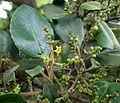
The trocaz pigeon, Madeira laurel pigeon or long-toed pigeon is a pigeon which is endemic to the island of Madeira. It is a mainly grey bird with a pinkish breast; its silvery neck patch and lack of white wing markings distinguish it from its close relative and probable ancestor, the common wood pigeon. Its call is a characteristic six-note cooing, weaker and lower-pitched than that of the wood pigeon. Despite its bulky, long-tailed appearance, this pigeon has a fast, direct flight.

Bolle's pigeon is a species of the genus Columba of family Columbidae, doves and pigeons, endemic to the Canary Islands, Spain. This bird is named after the German naturalist Carl Bolle, who was the first to distinguish it from the laurel pigeon. This wood pigeon is endemic to the laurel forest habitat.

The laurel pigeon or white-tailed laurel pigeon is a species of bird in the Columba genus in the family Columbidae. It is endemic to the Canary Islands, Spain, and resides in laurel forest habitat. It is the animal symbol of the island of La Gomera.
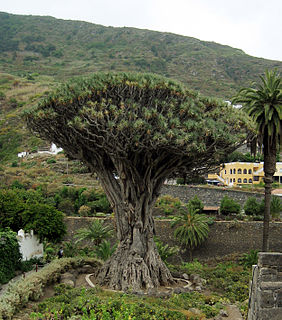
Dracaena draco, the Canary Islands dragon tree or drago, is a subtropical tree in the genus Dracaena, native to the Canary Islands, Cape Verde, Madeira, western Morocco, and is thought to be introduced in the Azores. It is the natural symbol of the island of Tenerife, together with the blue chaffinch. Its closest living relative is the dragon's blood tree of Socotra, Dracaena cinnabari.

Garajonay National Park is located in the center and north of the island of La Gomera, one of the Canary Islands (Spain). It was declared a national park in 1981 and a World Heritage Site by UNESCO in 1986. It occupies 40 km2 and it extends into each of the six municipalities on the island.

Adansonia suarezensis, the Suarez baobab, is an endangered species of Adansonia endemic to Madagascar. It is locally called "bozy", the common name used for all baobabs in northern Madagascar.

Ilex canariensis, the small-leaved holly, is an endemic species of holly native to Macaronesian islands. It is a species of plant in the family Aquifoliaceae. It is found in the Macaronesian islands of Madeira (Portugal) and Canary Islands (Spain).

Laurus azorica, the Azores laurel or Macaronesian laurel is a species of plant in the laurel family (Lauraceae). It is endemic to the Azores.

Ocotea foetens, commonly called til or stinkwood is a species of tree in the family Lauraceae. It is evergreen and grows up to 40 m tall. It is a common constituent of the laurisilva forests of Madeira and the Canary Islands. Leaf fossils of this species are known from the Mio-Pleistocene of Madeira Island.

Persea indica is a species of plant in the family Lauraceae. It belongs to the evergreen tree genus Persea of about 150 species, of which the avocado, P. americana, is the best known.

Rhamnus integrifolia, also known as moralito, is a species of flowering plant in the family Rhamnaceae.

Sideroxylon mirmulans, commonly known as marmulano, is a species of flowering plants in the family Sapotaceae. It is endemic to the Madeira Islands (Portugal). It is threatened by habitat loss.

Hypericum canariense is a species of flowering plant in the family Hypericaceae known by the common name Canary Islands St. John's wort. It is the sole member of Hypericumsect. Webbia.

Rhamnus alaternus is a species of flowering plant in the buckthorn family Rhamnaceae, known by the common names Italian buckthorn or Mediterranean buckthorn. It is a hardy medium-sized evergreen shrub with fragrant flowers.

Laurus novocanariensis is a large shrub or tree with aromatic, shiny dark-green foliage. belonging to the evergreen tree genus Laurus of the laurel family, Lauraceae. The genus includes three species, whose diagnostic key characters often overlap. Under favorable conditions it is an impressive tree of 3 to 20 m. tall. It is native of rich soils in the cloud zone of always moist spots in subtropical climate with a high air-humidity, on the Canary and Madeira islands.
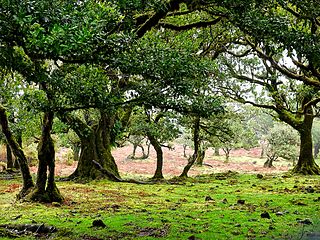
The Madeira evergreen forests is a laurissilva ecoregion of southwestern Europe. It covers the archipelago of Madeira and some nearby islands in the Atlantic Ocean. Laurel forest, known as laurissilva, once covered the islands. Over centuries the forests were mostly cleared. Madeira's remaining forests are now protected.

Sideroxylon canariense is a species of flowering plant in the family Sapotaceae. It It is endemic to the Canary Islands.
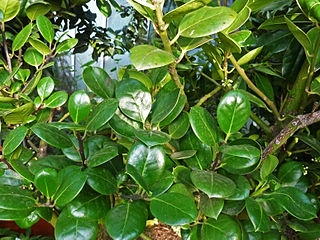
Ilex perado, the Macaronesian holly, is a species of holly endemic to Macaronesia, distributed throughout the Azores, Madeira and Canary islands. It is an important component of the natural high-altitude Macaronesian rainforest, known as 'laurisilva', found mostly at 500 to 1,200 m altitude but it also appears in forest formations at lower altitudes. Many of the subspecies have been classified as threatened, probably because of very small population sizes, and are protected by local, national and regional legislation.
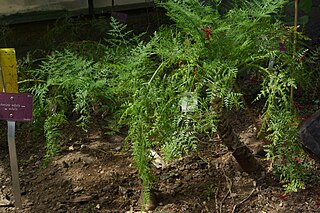
Daucus edulis is a critically endangered species of the celery family Apiaceae. It is endemic to Madeira.

Culcita macrocarpa, or the woolly tree fern, is a species of tree fern of the family Culcitaceae native to Macaronesia and parts of the Iberian Peninsula. It is the only tree fern native to Europe.


